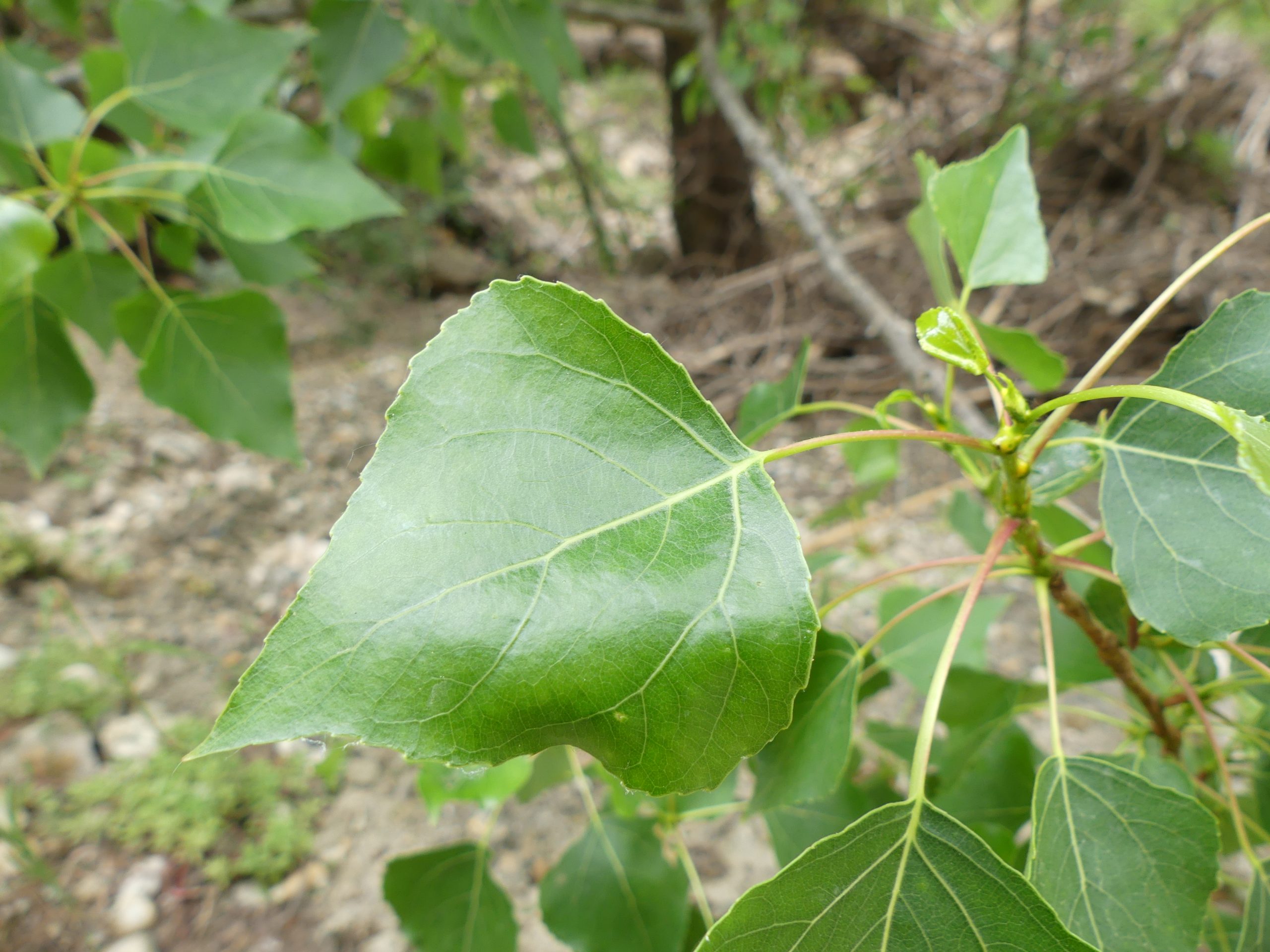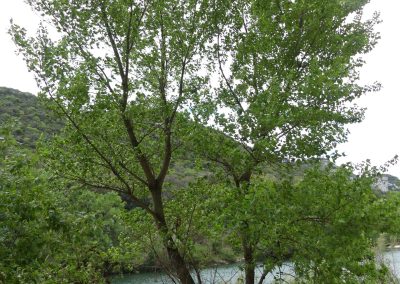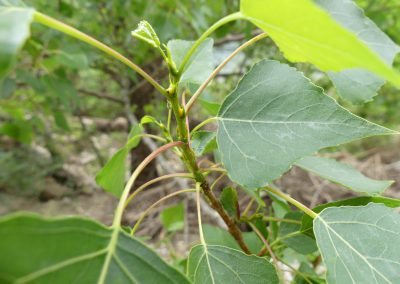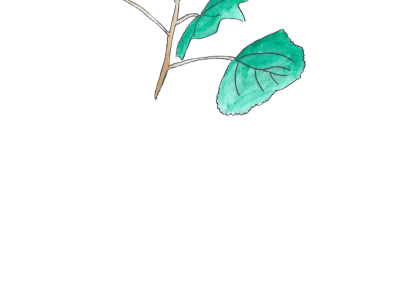Populus nigra
Scientific description
Taxon: Populus nigra
Class: Eudicotyledons
Subclass: Rosids
Order: Malpighiales
Family: Salicaceae
Common name: Black poplar
Origin:
Central and Southern Europe, temperate Asia, North Africa.
Description:
Deciduous tree up to 30 m with spreading, rounded crown. Bark cracks early and longitudinally. Leaves triangular or deltoid, finely toothed, glossy and smooth. Flowers appear March–April. Dioecious: male and female flowers on separate trees.
Propagation:
Primarily by cuttings or root suckers; seed propagation possible in female trees.
Ecology:
Prefers wet habitats: riverbanks, floodplains, deep moist soils. Common in riparian zones.
Uses:
Wood for carpentry and light construction. Bark contains salicylic acid (like aspirin). Used in windbreaks and reforestation.
Threats:
Least Concern, but vulnerable to drought and hydrological changes due to climate change.
Taxon: Populus nigra
Classe: Eudicotylédones
Sous-classe: Rosidées
Ordre: Malpighiales
Famille: Salicacées
Nom commun: Peuplier noir
Origine:
Europe centrale et méridionale, Asie tempérée, Afrique du Nord.
Description:
Arbre caduc jusqu’à 30 m avec port étalé et couronne ronde. Écorce fissurée longitudinalement. Feuilles triangulaires ou deltoïdes, finement crénelées, très luisantes. Floraison dioïque mars–avril.
Multiplication:
Principalement par bouturage ou rejets de souche ; reproduction sexuée via graines chez les femelles.
Écologie:
Zones humides : rives, alluvions, sols profonds et frais. Commun en zones riveraines.
Utilisation:
Bois en menuiserie légère. Écorce contient acide salicylique (propriétés proches de l’aspirine). Arbre pour haies brise-vent et reboisement.
Menaces:
Préoccupation mineure, vulnérable face aux sécheresses et changements hydrologiques liés au climat.
Taxon: Populus nigra
Clasă: Eudicotiledonate
Subclasă: Rosidae
Ordin: Malpighiales
Familie: Salicaceae
Nume comun: Plop negru
Origine:
Europa Centrală și de Sud, Asia temperată, Africa de Nord.
Descriere:
Arbore cu frunze căzătoare până la 30 m, coroană largă și rotundă. Scoarța se crapă longitudinal devreme. Frunze triunghiulare sau deltoide, lucioase și netede. Specie dioică: arbori separați pentru flori masculine și feminine. Florare martie–aprilie.
Propagare:
Prin butași sau drajoni; semințe posibile la arborii femele.
Ecologie:
Preferă zone umede – maluri de râuri, câmpii aluvionare, soluri adânci și umede. Frecvent în zone riverane.
Utilizare:
Lemn pentru tâmplărie și construcții ușoare. Scoarța conține acid salicilic. Folosit în perdele forestiere și reîmpăduriri.
Amenințări:
Risc scăzut, dar sensibil la secetă și modificări hidrologice cauzate de schimbările climatice.
Ταξινόμηση: Populus nigra
Κλάση: Δικοτυλήδονα
Υποκλάση: Ροσίδες
Τάξη: Malpighiales
Οικογένεια: Salicaceae
Κοινή ονομασία: Μαύρη λεύκα
Προέλευση:
Κεντρική και νότια Ευρώπη, εύκρατη Ασία, βόρεια Αφρική.
Περιγραφή:
Φυλλοβόλο δέντρο έως 30 μ., με απλωμένη και σφαιρική κόμη. Φλοιός σχίζεται κατά μήκος. Φύλλα τρίγωνα ή δελτοειδή, γυαλιστερά και λεία. Δίοικο είδος – διαφορετικά δέντρα για αρσενικά και θηλυκά άνθη. Άνθιση Μάρτιος–Απρίλιος.
Πολλαπλασιασμός:
Με μοσχεύματα ή παραφυάδες. Σπόροι μόνο σε θηλυκά δέντρα.
Οικολογία:
Προτιμά υγρά περιβάλλοντα – όχθες ποταμών, πλημμυρικά πεδία, βαθιά και υγρά εδάφη. Κοινό σε παραποτάμιες περιοχές.
Χρήση:
Ξύλο για ξυλουργικές εργασίες και ελαφρές κατασκευές. Φλοιός περιέχει σαλικυλικό οξύ. Χρησιμοποιείται σε ανεμοφράκτες και αναδασώσεις.
Απειλές:
Είδος ελάχιστης ανησυχίας, ευάλωτο σε ξηρασία και αλλαγές υδρολογίας λόγω κλίματος.
Creative writing inspired by Populus nigra
Black poplar
Once upon a time, in a small town not far from Avignon, there lived a young herbalist named Lilou. Passionate about plants, she spent her days exploring the surrounding forest, looking for new species to enrich her culture.
One day, as she ventured further afield than usual, Lilou came across a mysterious plant with shiny leaves and bright purple flowers. She decided to pick it up and study it. She soon discovered that the plant had exceptional properties for relieving bronchitis and other respiratory ailments.
Shortly afterwards, a young man named Tom from the same town fell ill. He was suffering from persistent bronchitis which prevented him from leading a normal life. He sought advice from his best friend Tifannie, who told him about her healing cousin Lilou. He set out to meet her. One evening in February, he went to a restaurant with Tifannie and Lilou. He was out of breath, but his eyes sparkled with determination.
Touched by his condition, she offered to treat him with the plant she had discovered. As the days went by, Lilou constantly went to Tom's house in the evenings to deliver remedies. Each visit was an opportunity to exchange smiles, laughter, and stories. They discovered that they shared not only a love of nature, but also similar dreams and aspirations.
In time, Tom began to heal, but what was even more beautiful was the bond that developed between him and Lilou. They would spend hours walking together in the forest, discussing their hopes for the future.
One evening, when Lilou was due to return home, Tom took her hand before leaving and confessed his feelings. Lilou was moved and told him she felt the same way.
They decided to grow this precious plant together, not only to help others, but also to symbolize their growing love. And so Lilou and Tom's love blossomed, just like the plant that had been the starting point of their story. They lived happily ever after, surrounded by plants and love.






